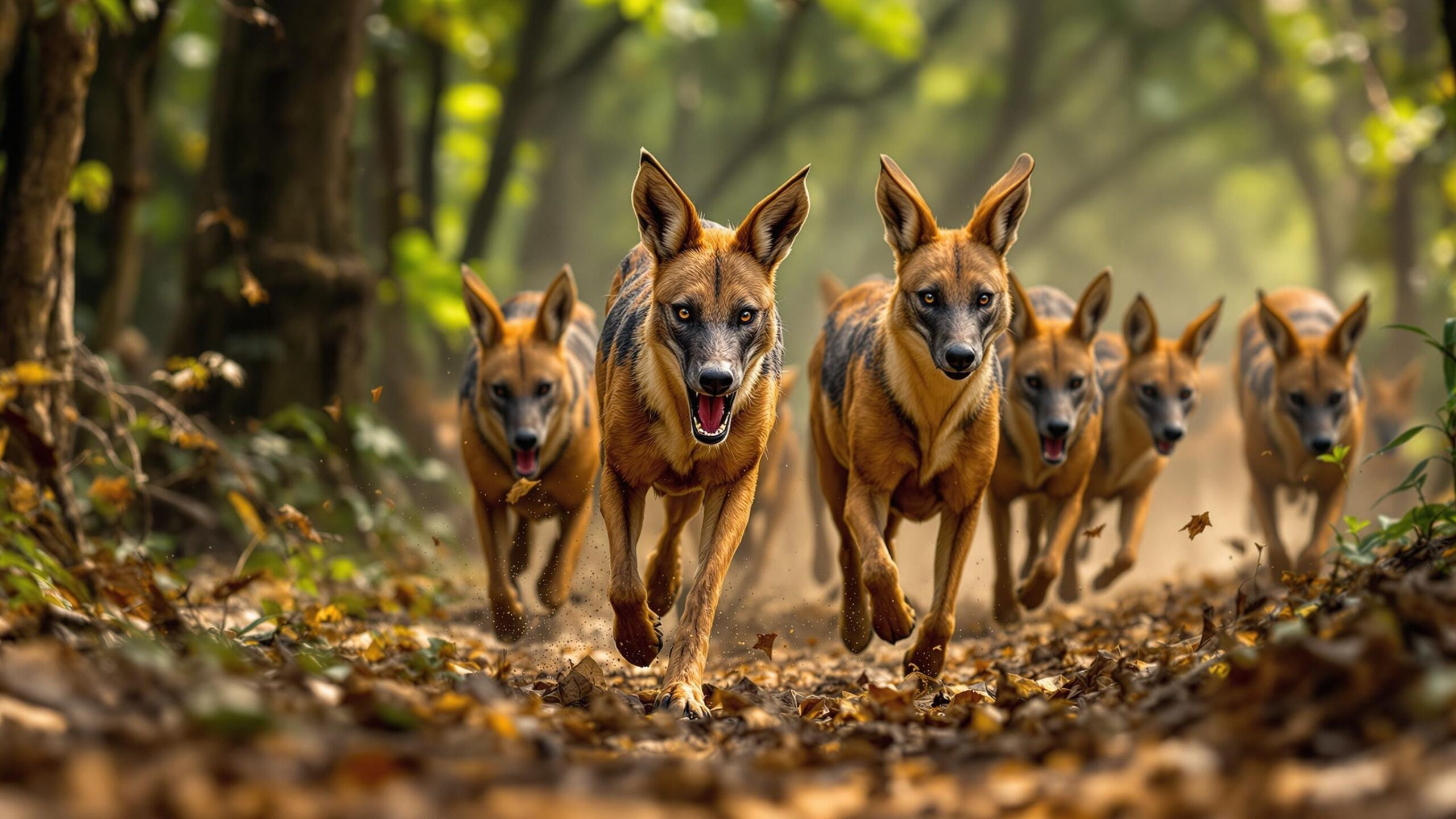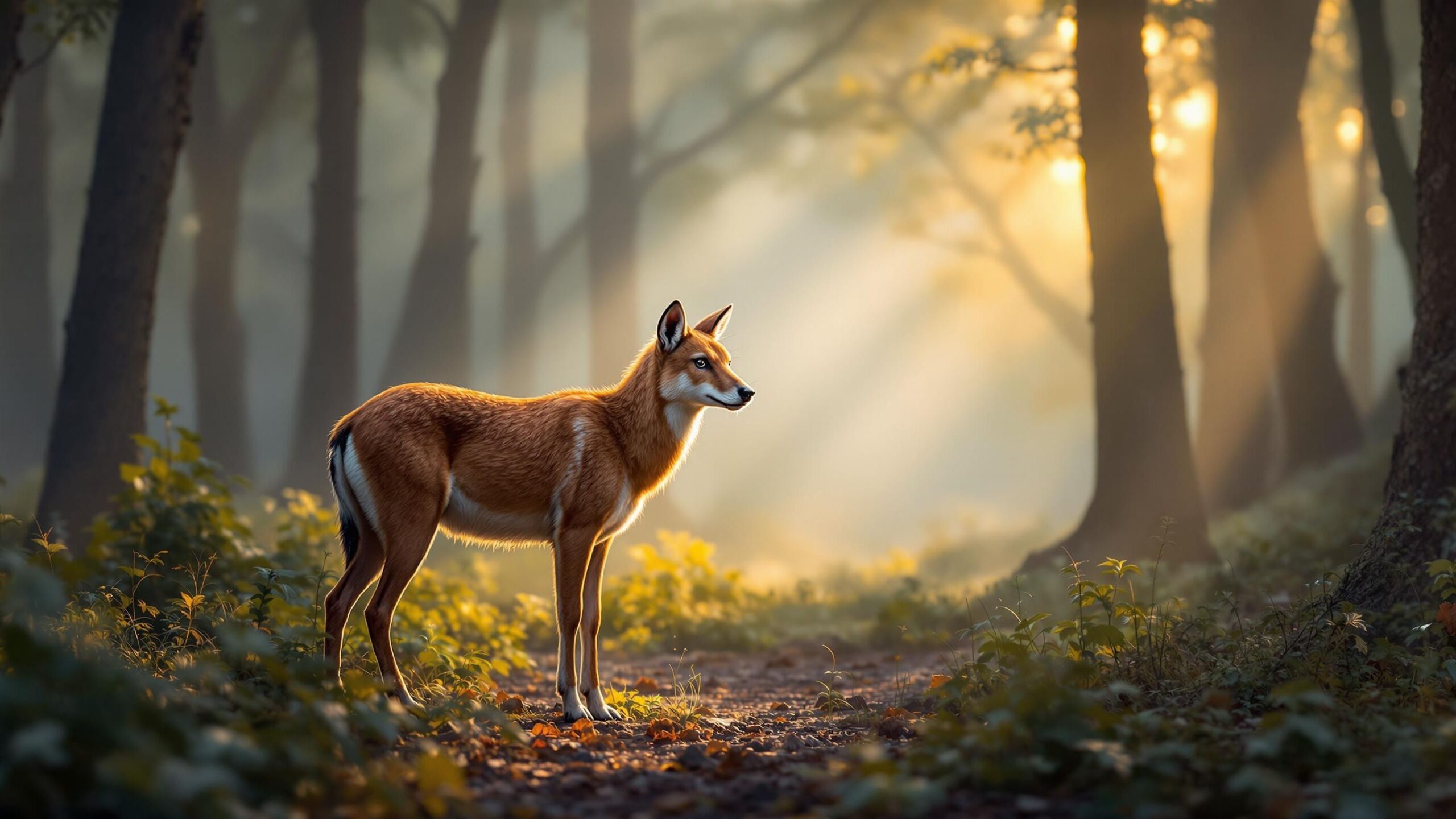The Indian Dhole: Asia’s Wild Crimson Hunter
Meet the Indian dhole (Cuon alpinus), one of the most enigmatic and misunderstood predators of Asia’s wild landscapes. Also known as the Asiatic wild dog, whistling dog, or red dog, the dhole is a strikingly social, fiercely intelligent, and ecologically vital canid that roams the dense jungles, deciduous forests, and mountainous terrains of the Indian subcontinent. Though often overshadowed by India’s more charismatic carnivores like the Bengal tiger or the Indian leopard, the dhole plays a unique and irreplaceable role in maintaining the balance of nature. Let us step into the world of this fiery-coated, elusive predator—where loyalty, coordination, and resilience define a life forged in the wild.
A Canine Unlike Any Other
Despite often being dubbed “wild dogs,” dholes are not simply feral versions of domesticated dogs or relatives of wolves. In fact, they are the sole surviving members of the genus Cuon, a distinct evolutionary lineage that diverged from other canids millions of years ago. Their anatomy and behavior set them apart. With a lean frame, bushy black-tipped tail, large rounded ears, and a short, fox-like muzzle, dholes are built for stamina and teamwork. Their coats range from rusty-red to sandy brown, providing camouflage in the Indian forests where they predominantly reside. The dhole’s dental structure is also unique. Unlike other wild canids, dholes have fewer molars—an evolutionary trait that allows them to shear meat more efficiently and devour their prey quickly. This adaptation, paired with their tightly-knit pack behavior, makes them highly effective predators.
Where the Wild Dholes Roam
India is the stronghold of the global dhole population, though fragmented groups can also be found in Nepal, Bhutan, and parts of Southeast Asia. Within India, dholes are most commonly found in protected areas and forest reserves such as Karnataka’s Nagarhole and Bandipur National Parks, the Western Ghats, and parts of Central and Northeast India.
Their preferred habitats are forests with dense undergrowth, rolling hills, and access to water bodies. Dholes are especially fond of deciduous and evergreen forests, where deer, wild boar, and other prey species are abundant. However, they are also surprisingly adaptable, capable of surviving in high-altitude Himalayan terrain, arid scrub forests, and montane woodlands—though they avoid human-dominated landscapes when possible.
Living in Packs: The Heart of Dhole Society
Social bonds are the cornerstone of dhole life. They live, hunt, and raise young in packs that typically range from five to twelve individuals, though super-packs of up to thirty dholes have been documented. Unlike other canids that operate under a strict alpha hierarchy, dhole packs tend to be more cooperative and democratic in their social structure.
Packs revolve around breeding pairs and a network of helpers. All members contribute to the care of pups, including regurgitating food for them—a behavior shared with only a handful of other wild carnivores. This communal lifestyle not only strengthens group cohesion but also enhances survival rates for offspring. Communication is key to their coordination. Dholes are known for their eerie, bird-like whistles—distinct vocalizations that differ from howls or barks. These sounds help pack members stay in contact in dense forests, signal danger, or orchestrate hunting strategies.
Masters of the Coordinated Hunt
The Indian dhole is a true embodiment of teamwork in action. While individual dholes are not physically powerful enough to take down large prey, the pack more than makes up for it through precision, endurance, and cooperation. Hunting is a well-orchestrated operation: they silently stalk their quarry, then burst into a relentless chase, exhausting the animal through sheer persistence.
Dholes are diurnal hunters, often active in the early morning or late afternoon. Their prey includes chital (spotted deer), sambar, wild boar, langurs, and even young gaur (Indian bison). Though they can sprint, their success often depends on their ability to outlast rather than outrun. Once the prey is cornered or fatigued, the dholes close in quickly, killing with sharp bites and dismembering the carcass within minutes to feed the entire pack before scavengers or larger carnivores arrive. They are pragmatic and not territorial toward other predators, but if challenged, a pack of dholes will aggressively defend their kill—even against leopards or sloth bears.

The Pups and the Process of Growing Up
Mating in dholes typically occurs between November and March, and the alpha female gives birth to a litter of 6 to 8 pups after a gestation period of about two months. The birthing usually takes place in a den dug into the earth—sometimes an abandoned burrow of a porcupine or a modified rocky crevice.
What makes the dhole unique among wild canids is the intensive cooperative care their young receive. The pups are raised not just by their mother and father, but by the entire pack. They are weaned around 10 weeks of age but continue to receive food through regurgitation for several more months. During this time, they learn the rules of the pack, hunting skills, and the complex cues that dictate life in the wild. The juveniles begin joining adult hunts by the time they are six to seven months old. However, it takes well over a year before they become fully integrated, independent members of the group. This extended nurturing period builds strong familial bonds and improves the pack’s success rate in hunting and pup rearing.
A Predator with a Precarious Future
Despite their prowess, dholes are quietly slipping through the cracks of conservation attention. Classified as “Endangered” by the International Union for Conservation of Nature (IUCN), dholes face a slew of challenges—many of them human-induced. Habitat fragmentation is perhaps the most critical. As forests shrink and human settlements expand, dhole territories are being squeezed into smaller, disconnected patches, reducing their access to prey and increasing the risk of inbreeding. Roads, railways, and fences not only divide habitats but also cause direct mortality through vehicle collisions.
Another major threat is competition with domestic dogs. Free-ranging dogs not only compete with dholes for food but also transmit deadly diseases like canine distemper and rabies. These outbreaks can decimate entire packs in short spans of time. Hunting and retaliatory killings still occur, especially in fringe villages where dholes are perceived as threats to livestock. Ironically, while dholes rarely target domestic animals when wild prey is abundant, they are still viewed as vermin in some regions—a reputation stemming more from myth than fact.
Coexisting with the Crimson Ghosts
Efforts are underway to protect the dhole and ensure its continued presence in India’s forests. Several protected reserves across southern and central India have witnessed stable or even increasing dhole populations thanks to better habitat protection and stricter anti-poaching laws.
Organizations such as the Wildlife Conservation Society (WCS) and the Wildlife Institute of India are studying dhole ecology, behavior, and genetics to inform policy decisions and landscape management. Community-based conservation, where local people are empowered to act as stewards of the forest, is proving especially effective in areas bordering dhole habitats.
Education and outreach are vital. The more people understand the dhole’s role in maintaining healthy prey populations and forest ecosystems, the more likely they are to support conservation measures. These crimson hunters deserve a place in India’s collective wildlife heritage—not just as a footnote to the tiger or leopard, but as a remarkable species in their own right.
A Silent Force in the Forest
In many ways, the dhole is an underdog—not only in the ecological food chain but in the public imagination. But those who have had the privilege to watch a dhole pack in action, gliding silently through sal forests or darting between bamboo groves, never forget the experience. There’s something primal and poetic about them: the fire-colored coat streaking through the trees, the eerie whistle echoing in the canopy, the flash of eyes before a coordinated chase.
These animals are more than predators. They are forest custodians, clan dwellers, and evolutionary marvels that have withstood ice ages, megafauna extinctions, and the march of civilization. But their future is now tethered to the decisions we make—about land, wildlife, and our relationship with the natural world. In the Indian dhole, we see a creature that exemplifies endurance, unity, and grace under pressure. To lose it would be to lose a piece of the wild soul of India.

The Road Ahead: Hope Through Awareness
What lies ahead for the Indian dhole depends largely on awareness and political will. As India grapples with its dual needs for development and conservation, striking a balance will be key. Expanding wildlife corridors, ensuring prey abundance, regulating free-ranging dog populations, and involving local communities are all essential components of dhole conservation.
Encouraging ecotourism that respects dhole habitats can also shift public perception. When people see the dhole not as a pest but as a keystone species worthy of admiration, the wheels of protection begin to turn. The dhole doesn’t demand the spotlight, nor does it need grand declarations. It simply needs space, safety, and the recognition that its role in nature is no less important than that of the more glamorous big cats. If given the chance, these crimson hunters will continue to whistle through India’s forests, quietly shaping the ecosystems they call home.
Listening for Whistles in the Wild
So the next time you find yourself wandering through the woods of South India or exploring the bamboo thickets of Central India, keep your senses alert. You may not see the dhole before it sees you—but you might hear its whistle, soft and eerie, cutting through the stillness of the forest. It’s a sound that reminds us that not all heroes wear stripes or roar. Some, like the dhole, lead through silence, unity, and an untamed elegance all their own.

